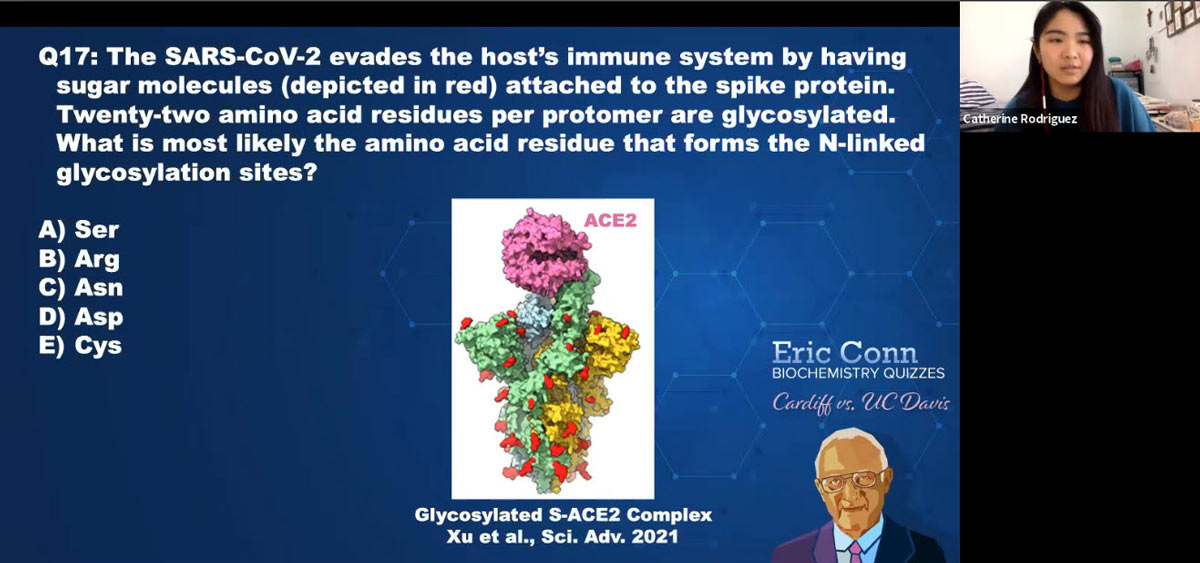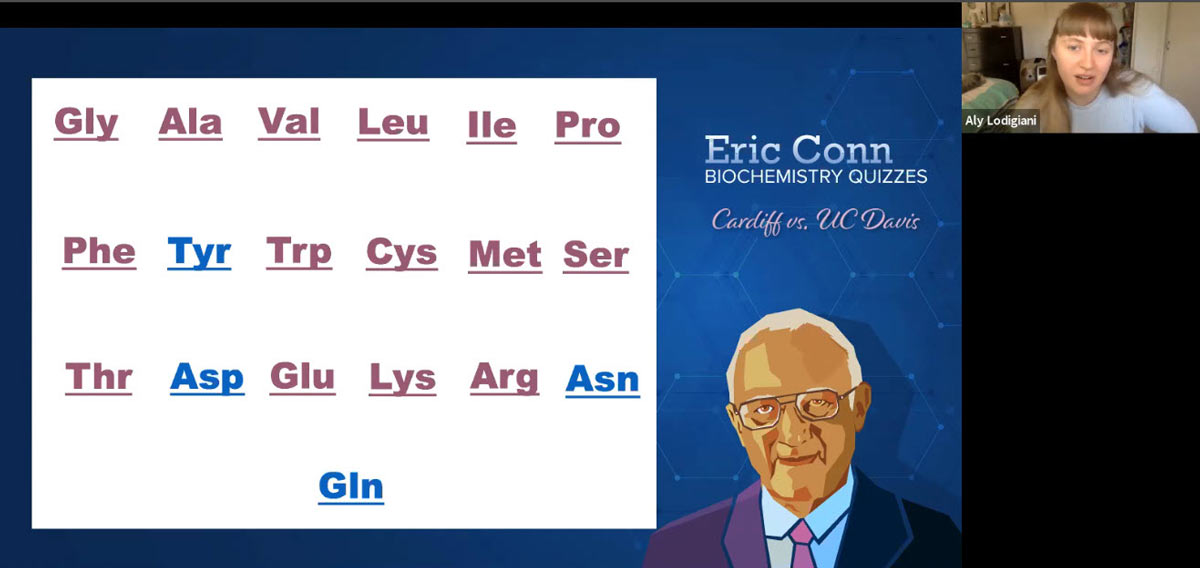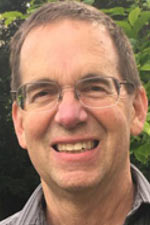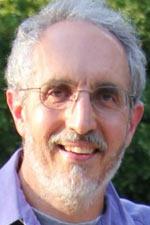Quick Summary
- A different kind of Zoom event proves to be unforgettable experience for students
- 300 people log in for two UC Davis prelims, followed by the main event
- See the connections between UC Davis and Cardiff faculty
They reached across the ocean, 5,000 miles away, and delighted in the challenge, the congeniality and the conviviality of the final event in the Eric Conn Memorial Biochemistry Quizzes.
The final, last Wednesday (March 10), not only memorialized a UC Davis plant biochemist, but offered “Zoom fatigue relief” for UC Davis undergraduate students and Cardiff University students, said the organizer and moderator, Walter Leal, UC Davis distinguished professor of molecular and cellular biology.
QUIZ NAMESAKE
Professor Conn (1923-2017), a UC Davis faculty member for 43 years, was the third recipient of the UC Davis Prize for Undergraduate Teaching and Scholarly Achievement. He received the Academic Senate’s Distinguished Teaching Award in 1974 and the senate’s highest honor, the Faculty Research Lecturer Award (now called the Faculty Distinguished Research Award), in 1977. He was a member of the National Academy of Sciences.Read more about Conn here, and hear from him in this video.
“They had so much fun,” he said. “Ten years from now, most of these students will be in another field and professions unrelated to biochemistry. Those not remaining in biochemistry will probably forget everything they learned this quarter. However, all students who participated will never forget this experience. In the middle of a pandemic and suffering from Zoom fatigue, they made new friends across the pond. Eric Conn would be happy to see undergraduate students having this experience.”
UC Davis won the event, but “UC Davis had a competitive advantage because this was their second game,” Leal noted. “Everything was new for Cardiff. Additionally, the contents of our syllabi differ.”

Catherine Rodriguez, a microbiology major, captained the six-member UC Davis team, called the Ironic Bonds. Fellow team members: Mary Aina (psychology major), Kelly Brandt (biochemistry and molecular biology), Jiaying Liu (biological sciences), Aly Lodigiana (cellular biology) and Efrain Vasquez Santos (neurobiology, physiology and behavior).
The Cardiff team: spokesperson Jessie Vaughan and members Kia Blackburn, Marianna Gisdaki, Alice Pike, Anastasia Rouchota and Ellie Whitworth.
‘The world we live in’
“The Cardiff team did a marvelous job,” Leal said. “It was a pleasure seeing Jessica and her team more than 5,000 miles away playing on the screen. That’s the world we live in: global learning.”

The event also created friendships. “A student from UC Davis reached out to become an electronic pen pal with Cardiff students,” Leal said, adding that “both Cardiff and UC Davis parents wrote direct emails indicating how pleased they were with the event.”
The deans will exchange hoodies and all participants will receive certificates and gift cards.
UC Davis Chancellor Gary S. May delivered the welcoming address. While the students worked on their answers, Dean Blumberg, chief of pediatric infectious diseases at UC Davis Children’s Hospital, answered questions on COVID-19 vaccines.
Nearly 300 people logged in for the day’s program, which started with two UC Davis semifinals — Ironic Bonds vs. Gibbs, and Alpha Helices vs. Beta Strands, the teams that advanced from campus preliminaries in February. The Ironic Bonds team, victorious in its semifinal against Gibbs, would be joined by one member of the Alpha Helices in the final vs. Cardiff.
Davis-Cardiff connections
Although the two universities are an ocean away, several faculty share close ties. One of the Cardiff judges, Professor John Harwood, did his first postdoctoral studies at UC Davis with the late Professor Paul Stumpf, who, along with Conn, founded the Department of Biochemistry. Harwood knew both Conn and Stumpf well, especially with their labs close to one another.


Other judges were Charles Gasser, UC Davis professor emeritus; Clark Lagarias, UC Davis distinguished research professor and a member of the National Academy of Sciences; and D. Dafydd Jones of the Cardiff faculty.
Professor Conn also enjoyed close ties with Professor Gasser. “It was Eric who persuaded Charles, then in the private sector, to apply for a position at UC Davis,” Leal said. “Then when Charles joined UC Davis faculty, Eric gave him his lab, which he used until his retirement.”
Two Cardiff faculty members with links to UC Davis assisted with organizing the event and reading the questions:
- Mark Young, a senior lecturer, lived in Davis as a child while his father, Thomas Young, taught brewing at UC Davis
- Wynand van der Goes van Naters, a lecturer, is an associate of Leal’s, going back to when they both lived and worked in Japan. “His research is also focused on insect olfaction,” Leal said. “He was the person I reached out to make the initial contact.”
Questions and answers

Here are some of the questions from Wednesday’s program (click each question to see the answer):
- What is one of the ways that humans adapt to high altitudes by virtue of what happens to hemoglobin?
- Increase production of a compound named 2,3-BPG that leads to increase delivery of oxygen.
- Which portion of the spike protein moves up and down to either evade the immune system or allow virus entry to the host cell to occur?
- The receptor-binding domain.
- A1c is a blood test that measures your average blood sugar levels over the past three months. The A1c test measures the percentage of your red blood cells that have sugar-bound hemoglobin. Which ligand binds to hemoglobin as your blood sugar does, albeit in a reversible fashion?
- Carbon dioxide.
- Why can crocodiles stay underwater for such a long time without drowning?
- Their hemoglobin binds to bicarbonate and reduces affinity for oxygen (at the tissues).
- In the so-called UK variant of the SARS-CoV-2 virus, the amino acid residue asparagine in the receptor-binding domain at position 501 is replaced by which amino acid?
- Tyrosine.
- Why the change of a single amino acid, glutamic acid to valine, in hemoglobin leads to sickle cell disease?
- It causes aggregation of hemoglobin due to hydrophobic interactions.
Media Resources
Kathy Keatley Garvey is a communications specialist with the Department of Entomology and Nematology. This article originally appeared in her Bug Squad blog. Email: kegarvey@ucdavis.edu.
